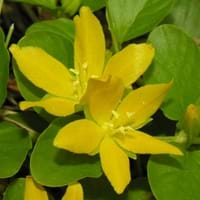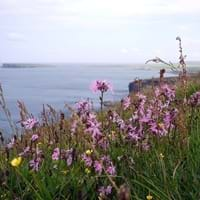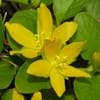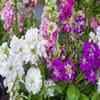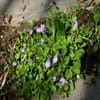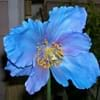Life Span
Perennial
Perennial
Type
Flowering Plants, Perennial
Perennial
Origin
Europe
Europe, Eastern Europe, Northern Europe, Southern Europe, Western Europe, Russia, Siberia
Types
creeping jenny
not available
Habitat
Near ponds, River side, Wet ground
damp meadows, ditches, Fields, Hay fields, shores, springs, Swamps
USDA Hardiness Zone
4-8
3-7
Sunset Zone
1a, 1b, 2a, 2b, 3a, 3b, 4, 5, 6, 7, 8, 9, 14, 15, 16, 17, 18, 19, 20, 21, 22, 23, 24
1a, 1b, 2a, 2b, 3a, 3b, 4, 5, 6, 7, 14, 15, 16, 17
Habit
Spreading
Rosette/Stemless
Flower Color
Yellow
White, Pink, Light Pink, Rose
Flower Color Modifier
Bicolor
Bicolor
Fruit Color
Not Available
Purple, Bronze, Brown
Leaf Color in Spring
Green
Green
Leaf Color in Summer
Green
Dark Green
Leaf Color in Fall
Green
Dark Green
Leaf Color in Winter
Light Green
Light Green
Leaf Shape
Ovate
Long linear and narrow
Plant Season
Spring, Summer, Fall
Spring, Summer
Sunlight
Full Sun, Partial Sun, Partial shade, Full Shade
Full Sun, Partial Sun
Type of Soil
Clay, Loam
Clay, Loam, Sand
The pH of Soil
Acidic, Neutral
Acidic, Neutral, Alkaline
Soil Drainage
Average
Average
Bloom Time
Late Spring, Early Summer
Late Spring, Early Summer
Tolerances
Drought
Drought
Where to Plant?
Container, Ground, Pot
Container, Ground, Pot
How to Plant?
Stem Planting
Divison, Seedlings
Plant Maintenance
Medium
Low
Watering Requirements
Requires a lot of watering, Requires regular watering
Water daily during growing season
In Summer
Lots of watering
Lots of watering
In Spring
Moderate
Moderate
In Winter
Average Water
Average Water
Soil pH
Acidic, Neutral
Acidic, Neutral, Alkaline
Soil Type
Clay, Loam
Clay, Loam, Sand
Soil Drainage Capacity
Average
Average
Sun Exposure
Full Sun, Partial Sun, Partial shade, Full Shade
Full Sun, Partial Sun
Pruning
Remove damaged leaves, Remove dead branches, Remove dead leaves
Remove deadheads
Fertilizers
All-Purpose Liquid Fertilizer
All-Purpose Liquid Fertilizer, Fertilize in early spring, Fertilize the soil before planting, organic fertlizers, slow-release fertilizers
Pests and Diseases
Pests and diseases free
Healthy tree
Plant Tolerance
Drought
Drought
Flower Petal Number
Single
Single
Foliage Texture
Medium
Medium
Foliage Sheen
Glossy
Glossy
Attracts
Not Available
Bees, Bumblebees, Butterflies, Hoverflies, Insects
Allergy
Asthma
allergic reaction
Aesthetic Uses
Beautification, Bouquets, Used for decorating walls, fences, gates, hedges, etc.
Showy Purposes
Beauty Benefits
Not Available
Skin irritation, Skin Problems
Environmental Uses
Provides ground cover
Air purification
Medicinal Uses
Diarrhea
Not Available
Part of Plant Used
Flowers, Leaves
Whole plant
Other Uses
Used as Ornamental plant
Oil is used in perfume, soaps, creams, etc., Used as Ornamental plant
Used As Indoor Plant
No
No
Used As Outdoor Plant
Yes
Yes
Garden Design
Container, Edging, Groundcover, Hanging Basket, Mixed Border, Water Gardens
Bog Garden, Wildflower
Botanical Name
LYSIMACHIA nummularia 'Goldilocks'
LYCHNIS flos-cuculi
Common Name
Creeping jenny, moneywort, herb twopence and twopenny thot
Ragged Robin
In Hindi
Lysimachia Nummularia
Ragged Robin
In German
Lysimachia Nummularia
Kuckucks-Lichtnelke
In French
Lysimaque nummulaire
Ragged Robin
In Spanish
Lysimachia nummularia
petirrojo desigual
In Greek
Λυσιμαχία nummularia
ragged Robin
In Portuguese
Lysimachia nummularia
Ragged Robin
In Polish
tojeść rozesłana
Ragged Robin
In Latin
Lysimachiam nummularia
Robin ragged
Phylum
Tracheophyta
Anthophyta
Class
Magnoliopsida
Equisetopsida
Order
Ericales
Caryophyllales
Family
Primulaceae
Caryophyllaceae
Clade
Angiosperms, Asterids, Eudicots
Angiosperms, Core eudicots, Eudicots
Tribe
Not Available
Not Available
Subfamily
Not Available
Not Available
Number of Species
Not Available
Not Available
Season and Care of Lysimachia Nummularia and Ragged Robin
Season and care of Lysimachia Nummularia and Ragged Robin is important to know. While considering everything about Lysimachia Nummularia and Ragged Robin Care, growing season is an essential factor. Lysimachia Nummularia season is Spring, Summer and Fall and Ragged Robin season is Spring, Summer and Fall. The type of soil for Lysimachia Nummularia is Clay, Loam and for Ragged Robin is Clay, Loam, Sand while the PH of soil for Lysimachia Nummularia is Acidic, Neutral and for Ragged Robin is Acidic, Neutral, Alkaline.
Lysimachia Nummularia and Ragged Robin Physical Information
Lysimachia Nummularia and Ragged Robin physical information is very important for comparison. Lysimachia Nummularia height is 510.00 cm and width 60.00 cm whereas Ragged Robin height is 61.00 cm and width 60.00 cm. The color specification of Lysimachia Nummularia and Ragged Robin are as follows:
Lysimachia Nummularia flower color: Yellow
Lysimachia Nummularia leaf color: Green
Ragged Robin flower color: White, Pink, Light Pink and Rose
- Ragged Robin leaf color: Green
Care of Lysimachia Nummularia and Ragged Robin
Care of Lysimachia Nummularia and Ragged Robin include pruning, fertilizers, watering etc. Lysimachia Nummularia pruning is done Remove damaged leaves, Remove dead branches and Remove dead leaves and Ragged Robin pruning is done Remove deadheads. In summer Lysimachia Nummularia needs Lots of watering and in winter, it needs Average Water. Whereas, in summer Ragged Robin needs Lots of watering and in winter, it needs Average Water.
